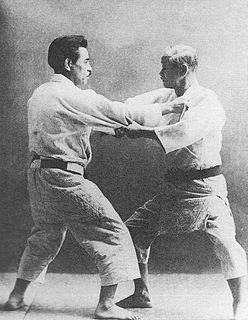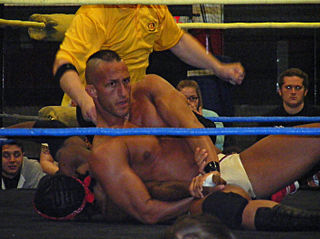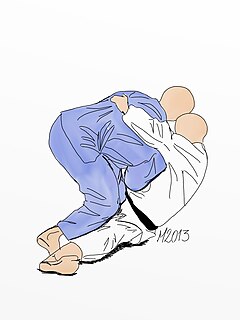
Judo is generally categorized as a modern Japanese martial art, which has since evolved into an Olympic and Paralympic event. The sport was created in 1882 by Jigoro Kano (嘉納治五郎) as a physical, mental, and moral pedagogy in Japan. With its origins coming from jujutsu, judo's most prominent feature is its competitive element, where the objective is to either throw or take down the opponent to the ground, immobilize or otherwise subdue the opponent with a pin, or force the opponent to submit with a joint lock or a choke. Strikes and thrusts by hands and feet as well as weapons defences are a part of judo, but only in pre-arranged forms and are not allowed in judo competition or free practice. It was also referred to as Kanō Jiu-Jitsu until the introduction to the Olympic event. A judo practitioner is called a "judoka", and the judo uniform is called "judogi".
In Japanese martial arts, the term atemi (当身) designates blows or strikes to the body, as opposed to twisting of joints, strangleholds, holding techniques and throws. Atemi can be delivered by any part of the body to any part of the opponent's body. They can be percussive or use "soft" power. Karate is a typical martial art focusing on percussive atemi. The location of nerve and pressure points, such as might be used for certain acupressure methods, also often informs the choice of targets for atemi.

Yoseikan budō (養正館武道) may be classified as a sōgō budō form, but is used here to indicate a martial art into which various martial ways have been integrated. It is probably most widely known for its descent from a pre-war style of aikido; however, it has important connections to judo, karate, western boxing, savate, and a traditional forms of Japanese combat known as gyokushin-ryū jujutsu and Tenshin Shōden Katori Shintō-ryū.
Tenjin Shinyo-ryu, meaning "Divine True Willow School", can be classified as a traditional school (koryū) of jujutsu. It was founded by Iso Mataemon Ryūkansai Minamoto no Masatari (磯又右衛門柳関斎源正足) in the 1830s. Its syllabus comprises atemi-waza, nage-waza, torae-waza and shime-waza. Once a very popular jujutsu system in Japan, among the famous students who studied the art were Kanō Jigorō, whose modern art of judo was greatly inspired by the Tenjin Shin'yō-ryū and Kitō-ryū.
Kitō-ryū (起倒流) is a traditional school (koryū) of the Japanese martial art of jujutsu. Its syllabus comprises atemi-waza, nage-waza, kansetsu-waza and shime-waza. The style is focused on throws and sweeps, and many of these techniques are designed to be performed while in full armor.

Kata guruma (肩車) is one of the traditional forty throws of judo as developed by Kano Jigoro. Kata guruma belongs to the third group of the traditional throwing list in the Gokyo no waza of the Kodokan Judo. It is also part of the current 67 Throws of Kodokan Judo. Because the technique is not a sweep nor a trip and requires tori to pull uke into a carry, it is categorized as a hand throwing technique (tewaza).

Kyuzo Mifune has been categorized as one of the greatest exponents of the art of judo after the founder, Kanō Jigorō. He is considered by many to be the greatest judo technician ever, after Kanō.

Hiza guruma (膝車) is one of the original 40 throws of Judo as developed by Kano Jigoro. It belongs to the first group of the traditional throwing list in the Gokyo no waza of the Kodokan Judo. It is also included in the current 67 throws of Kodokan Judo. It is classified as a foot technique (ashiwaza).

Ō goshi is one of the original 40 throws of Judo as compiled by Jigoro Kano.

The ippon seoi nage (一本背負投) is a throw in judo. It is a variant of Seoi nage, and is one of the nineteen accepted techniques in Shinmeisho No Waza of Kodokan Judo. It is classified as a hand throwing technique, or te-waza.

Hane goshi is a throw in judo. It is one of the original 40 throws of Judo as developed by Jigoro Kano. It belongs to the third group, Sankyo, of the traditional throwing list, Gokyo, of Kodokan Judo. It is also part of the current 67 Throws of Kodokan Judo. It is classified as a hip technique, Koshi-Waza. Hane goshi is also one of the 20 techniques in Danzan Ryu's Nagete list.

Ude-Hishigi-Waki-Gatame is an armlock and one of the official 29 grappling techniques of Kodokan Judo. It is one of the nine joint techniques of the Kansetsu-waza list, one of the three grappling lists in Judo's Katame-waza enumerating 29 grappling techniques. Falling directly to the mat while applying or attempting to apply the Waki gatame in competition is listed as an Hansoku-make by the International Judo Federation.

Ude-Hishigi-Sankaku-Gatame (腕挫三角固), also referred to as Ao muke gata ude hishigi (背中方腕挫) in the Canon Of Judo, is one of the official 29 grappling techniques of Kodokan Judo. It is one of the nine joint techniques of the Kansetsu-waza list, one of the three grappling lists in Judo's Katame-waza, enumerating 29 grappling techniques, and is also demonstrated by Kyuzo Mifune in the video The Essence of Judo.

Yoko Otoshi (横落) is one of the original 40 throws of Judo as developed by Jigoro Kano. It belongs to the third group,
Hane Goshi Gaeshi is a throw in judo and is categorized as a foot technique, Ashi-waza. It is one of the techniques adopted later by the Kodokan into their Shinmeisho No Waza list.

Jujutsu, also known as jiu-jitsu and ju-jitsu, is a family of Japanese martial arts and a system of close combat that can be used in a defensive or offensive manner to kill or subdue one or more weaponless or armed and armored opponents. A subset of techniques from certain styles of jujutsu was used to develop many modern martial arts and combat sports, such as judo, aikido, sambo, ARB, Brazilian jiu-jitsu, and mixed martial arts.
The Nage-waza ura-no-kata is a judo kata that, like the Gonosen-no-kata, focuses on counter-attacks to throwing techniques. It was developed by Mifune Kyūzō, and is not an officially recognized Kodokan kata.
Tsubame Gaeshi (燕返し) is a Judo throw that falls within the seventeen techniques of the Shimmeisho no waza, officially recognised by the Kodokan in 1982. Literally translated as "Swallow Counter", Tsubame gaeshi is the countering of an ashi waza with Deashi harai from the opposite leg. A right-handed Deashi-harai executed by uke, for instance, would be avoided by tori bending his right knee, followed by a left-handed Deashi-harai. Tsubame gaeshi as a counter against uke's Deashi harai is the opening move of the Kaeshi-no-kata. As a counter against Okuriashi harai, it forms the sixth technique of the Nage-Waza-Ura-no-kata.
Atemi Ju-Jitsu, in Japanese: Atemi (当て身) Jujutsu (柔術), also called Pariset Ju-Jitsu, was established in France in the 1940s by the late Judo and Ju-Jitsu legend Bernard Pariset to revive and preserve old martial techniques inherited from Feudal Japan.
The Katame-waza ura-no-kata is a judo kata that can be considered as a complement to Mifune Kyūzō's Nage-waza ura-no-kata, but that instead focuses on counter-attacks to controlling techniques rather than throwing techniques. It was compiled by Itō Kazuo from techniques developed by other Japanese newaza experts, and is not an officially recognized Kodokan kata.












